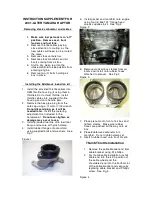
WARNING!
•
Never leave children alone in a vehicle, or
with access to an unlocked vehicle. Allow-
ing children to be in a vehicle unattended is
dangerous for a number of reasons. A child
or others could be injured seriously or
fatally. Do not leave the key fob in or near
the vehicle (or in a location accessible to
children), and do not leave the ignition of a
vehicle equipped with Keyless Enter-N-Go
in the ACC or ON/RUN mode. A child could
operate power windows, other controls, or
move the vehicle.
•
Ensure the parking brake is fully disen-
gaged before driving. Failure to do so can
lead to brake failure, and an accident.
BRAKE SYSTEM
Your vehicle is equipped with dual hydraulic
brake systems. If either of the two hydraulic
systems loses normal capability, the remaining
system will still function. However, there will be
some loss of overall braking effectiveness. You
may notice increased pedal travel during appli-
cation, greater pedal force required to slow or
stop, and potential activation of the “Brake Sys-
tem Warning Light.”
In the event power assist is lost for any reason
(i.e., repeated brake applications with the en-
gine off) the brakes will still function. However,
the effort required to brake the vehicle will be
much greater than that required with the power
system operating.
Brake Pad Break-In
NOTE:
Your vehicle is equipped with a high perfor-
mance braking system. The brake pads are a
semi-metallic compound, which offer supe-
rior fade resistance for consistent operation.
A compromise to using this type of brake
pad is that the brakes may squeal slightly
under certain weather and operating condi-
tions (.i.e., during light brake applications).
The brakes on your new vehicle do not require a
long break-in period. However, you should avoid
repeated hard brake applications from high
speeds during initial break-in. In addition, you
should avoid severe brake loading, such as may
be encountered when descending long moun-
tain grades.
Safe Operating Tips
WARNING!
To use your brakes and accelerator more
safely, follow these tips:
•
Do not “ride” the brakes by resting your foot
on the pedal. This could overheat the
brakes and result in unpredictable braking
action, longer stopping distances, or brake
damage.
•
When descending mountains or hills, re-
peated braking can cause brake fade with
loss of braking control. Avoid repeated
heavy braking by downshifting the trans-
mission whenever possible.
•
Do not drive too fast for road conditions,
especially when roads are wet or slushy. A
wedge of water can build up between the
tire tread and the road. This hydroplaning
action can cause loss of traction, braking
ability, and control.
•
After going through deep water or a car
wash, brakes may become wet, resulting in
decreased performance and unpredictable
braking action. Dry the brakes by gentle,
intermittent pedal action while driving at
very slow speeds.
122
Summary of Contents for Viper 2017
Page 2: ......
Page 3: ......
Page 5: ...2...
Page 45: ...42...
Page 100: ...Overview 8 4 NAV Temperature Controls 97...
Page 107: ...Operating Tips Chart 104...
Page 113: ...110...
Page 180: ...8 MAINTENANCE SCHEDULES MAINTENANCE SCHEDULE 178 177...
Page 181: ...MAINTENANCE SCHEDULE Refer to the Service And Warranty Handbook for maintenance schedules 178...
Page 182: ...9 IF YOU NEED CONSUMER ASSISTANCE IF YOU NEED ASSISTANCE 180 179...
Page 184: ...181...
Page 185: ...182...
Page 186: ...10 INDEX 183...
Page 200: ...8...
Page 201: ......
Page 202: ......
Page 204: ...7 9 9 B 9 B...
Page 205: ...I B I...
Page 206: ......
Page 207: ......
Page 234: ...8 4 1 5 0 6 O v T Ry 2 E H O 7 E H 3 R 5 I2 8 R 2 4 2 9 5 O RO eI2 eR 5...
Page 247: ......
Page 282: ...X...
Page 384: ...F G H J 8 L H 9 M 9 G...
Page 385: ......
Page 386: ...2 3 4 5 67 8 9 7 9 9 B 8...
Page 387: ......
Page 388: ......
Page 389: ...Viper 1 7 Z D 1 2 6 A R A A A...
















































